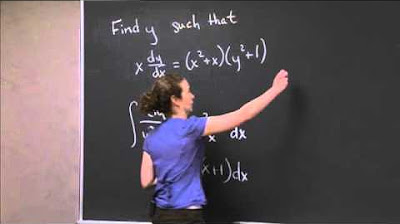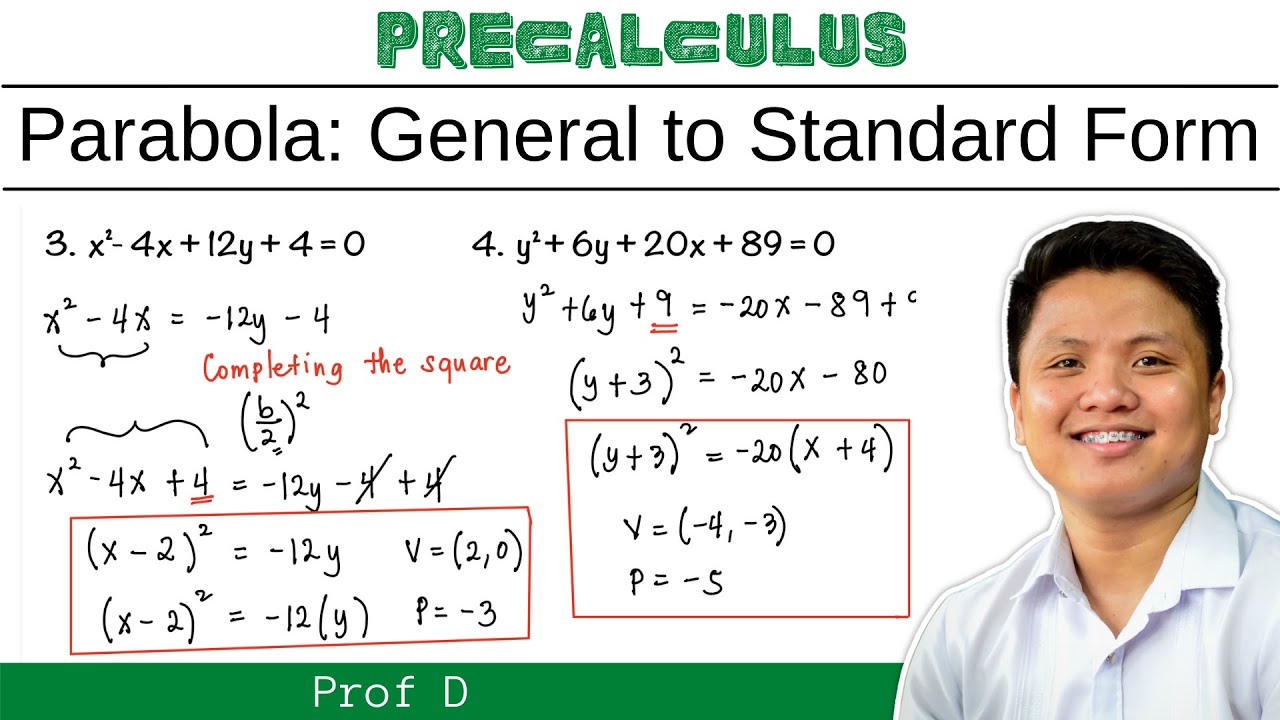Linear versus Nonlinear Differential Equations
TLDRIn this video, the presenter delves into the distinction between linear and nonlinear differential equations, a concept that can be challenging for some. The explanation begins with the mathematical definition of a linear differential equation in terms of Y, emphasizing that the coefficients in front of Y and its derivatives are pure functions of X, and all terms involving Y and its derivatives are to the first power. Several examples are provided to illustrate the difference, such as 'y double prime plus each of the x times y prime plus y equals sine X' which is linear, and 'y triple prime plus 3y y double prime plus y equals e to the X' which is nonlinear due to the multiplication of a function of Y with the second derivative. The presenter clarifies that for an equation to be considered linear, Y and all its derivatives must appear to the first power, and there should only be pure functions of X in front of them. This principle is consistently applied throughout the examples to reinforce understanding. The video aims to clarify this complex topic with clear examples, making it accessible to viewers.
Takeaways
- 📘 A differential equation is considered linear if it can be written in a form where the function Y and all its derivatives are multiplied by pure functions of X.
- 🔍 The order of a differential equation is determined by the highest derivative present in the equation.
- ✅ For an equation to be linear, Y and all its derivatives must appear to the first power.
- 🚫 A differential equation is nonlinear if it includes terms where Y or its derivatives are multiplied together or raised to a power other than one.
- 📊 The presence of a pure function of X (like e^x or sin(x)) in front of Y and its derivatives is a requirement for the equation to be considered linear.
- 🛑 If the equation has terms involving the product of Y and its derivatives, or if Y and its derivatives are raised to a power other than one, it is nonlinear.
- 🧮 The script provides several examples to illustrate the difference between linear and nonlinear differential equations.
- 📐 The script emphasizes that the key to identifying a linear differential equation is the presence of only pure functions of X and the first power of Y and its derivatives.
- ➗ The script clarifies that the square root of a derivative (like √(dy/dx)) would represent a nonlinear equation because it is not to the first power.
- 🔢 The script explains that the coefficients (a_n, a_(n-1), ..., a_0) in front of Y and its derivatives must be functions of X only.
- ✋ The script uses the term 'pure function of X' to describe functions that do not include Y or its derivatives, ensuring clarity on what constitutes a linear equation.
Q & A
What is the main topic discussed in the video?
-The main topic discussed in the video is the difference between linear and nonlinear differential equations.
What are the two conditions that define a differential equation as linear?
-The two conditions are: 1) In front of Y and all of its derivatives, you only have pure functions of X, and 2) Y and all of its derivatives are all to the first power.
What is the order of a differential equation?
-The order of a differential equation is the order of the highest derivative present in the equation.
In the given example 'y double prime plus each of the x times y prime plus y equals sine X', why is the equation considered linear?
-The equation is considered linear because it meets both conditions: it has pure functions of X in front of Y and its derivatives, and Y and its derivatives are all to the first power.
Why is the equation 'y triple prime plus 3y y double prime plus y equals e to the X' considered nonlinear?
-This equation is considered nonlinear because of the term '3y y double prime', which implies a product of Y and its derivative, violating the condition that Y and its derivatives must be to the first power.
What is the order of the differential equation 'x squared dy/dx plus y equals seven'?
-The order of the differential equation is one, as the highest derivative present is the first derivative 'dy/dx'.
Is the equation 'square root dy/dx plus 3y equals sine X' linear or nonlinear? Why?
-The equation is nonlinear because the term 'square root dy/dx' is not to the first power, as it is equivalent to '(dy/dx) to the one-half power'.
What is the reason why the equation 'Y double prime plus sine Y times y equals e to the X' is considered nonlinear?
-The equation is considered nonlinear because of the term 'sine Y times y', which is a function of Y and not a pure function of X, violating the condition for linearity.
What is a pure function of X?
-A pure function of X is a function that depends only on X and does not involve Y or its derivatives.
What does it mean for Y and its derivatives to be 'to the first power' in the context of differential equations?
-In the context of differential equations, Y and its derivatives being 'to the first power' means that they are not multiplied by each other or any other term; each term involving Y or its derivatives is to the power of one.
How can you determine if a given differential equation is linear based on the provided script?
-You can determine if a given differential equation is linear by checking if it meets the two conditions: 1) It has pure functions of X in front of Y and all of its derivatives, and 2) Y and all of its derivatives are to the first power.
What is the importance of understanding the difference between linear and nonlinear differential equations?
-Understanding the difference is crucial because linear differential equations often have well-established methods for solving them, while nonlinear equations may require more complex or specific approaches. This distinction can guide the choice of solution methods and the expected complexity of the problem.
Outlines
📚 Understanding Linear vs. Nonlinear Differential Equations
This paragraph introduces the topic of linear and nonlinear differential equations, emphasizing that it can be challenging for some learners. The presenter outlines the mathematical definition of a linear differential equation in Y, explaining that it must satisfy two conditions: coefficients in front of Y and its derivatives are pure functions of X, and Y and its derivatives are all to the first power. Several examples are provided to illustrate the difference between linear and nonlinear equations, such as 'y double prime plus each of the x times y prime plus y equals sine X' being linear, while 'y triple prime plus 3y y double prime plus y equals e to the X' is nonlinear due to the presence of a term involving a function of Y multiplied by a derivative.
🔍 Further Examples to Distinguish Linearity in Differential Equations
The second paragraph continues the discussion with more examples to solidify the concept of linearity in differential equations. It covers cases like 'x squared dy/dx plus y equals seven', which is linear because it meets the criteria of having pure functions of X in front of Y and its first derivative, and Y and its derivatives being to the first power. It also addresses why certain equations like 'square root dy/dx plus 3y equals sine X' and 'Y double prime plus sine Y times y equals e to the X' are nonlinear, highlighting that any term involving Y or its derivatives raised to a power other than one or within a function of Y disqualifies the equation from being linear. The presenter reiterates the criteria for linearity and encourages applying these rules to determine if an equation is linear or nonlinear.
Mindmap
Keywords
💡Linear Differential Equations
💡Nonlinear Differential Equations
💡Order of Differential Equation
💡Derivative
💡Pure Functions of X
💡Coefficients
💡First Power
💡Examples
💡Differential Equation Solutions
💡Function of Y
💡Differential Equation Classification
Highlights
The video discusses the difference between linear and nonlinear differential equations, which can be challenging for some people.
A differential equation is linear in Y if it can be written in a specific form involving only pure functions of X multiplied by Y and its derivatives.
Two conditions must be met for an equation to be considered linear: 1) Only pure functions of X are allowed in front of Y and its derivatives, and 2) Y and its derivatives must all be to the first power.
The order of a differential equation is determined by the highest derivative present in the equation.
The example equation y'' + x*y' + y = sin(x) is linear because it meets both conditions for linearity.
The equation y''' + 3*y*y'' + y = e^x is nonlinear due to the presence of the term 3*y*y'', which violates the linearity conditions.
The equation x^2 * (dy/dx) + y = 7 is linear because it meets both conditions for linearity, even though it involves a derivative.
The equation sqrt(dy/dx) + 3*y = sin(x) is nonlinear because the term sqrt(dy/dx) is not to the first power.
The equation y'' + sin(y)*y = e^x is nonlinear because it contains the term sin(y)*y, which violates the linearity conditions.
The equation y'' + cos(x) + y = e^x is nonlinear because it contains the term cos(x) + y, which is not a pure function of X.
In summary, an equation is linear if Y and all its derivatives appear to the first power, and in front of Y and its derivatives there are only pure functions of X.
The video provides multiple examples to illustrate the difference between linear and nonlinear differential equations.
Understanding the distinction between linear and nonlinear equations is important for solving and analyzing differential equations.
The video aims to make the topic more accessible by providing clear explanations and examples.
The presenter emphasizes the importance of the two conditions that must be met for an equation to be considered linear.
The video provides a comprehensive overview of the topic, making it suitable for both beginners and those with some prior knowledge.
By the end of the video, viewers should have a solid understanding of how to determine whether a given differential equation is linear or nonlinear.
Transcripts
Browse More Related Video

Differential Equation | MIT 18.01SC Single Variable Calculus, Fall 2010

Derivative Notation — Topic 51 of Machine Learning Foundations

How to use implicit differentiation on an equation for dy dx

Transforming General Form to Standard Form of Parabola | @ProfD

The Theory of 2nd Order ODEs // Existence & Uniqueness, Superposition, & Linear Independence

Partial derivatives - How to solve?
5.0 / 5 (0 votes)
Thanks for rating: